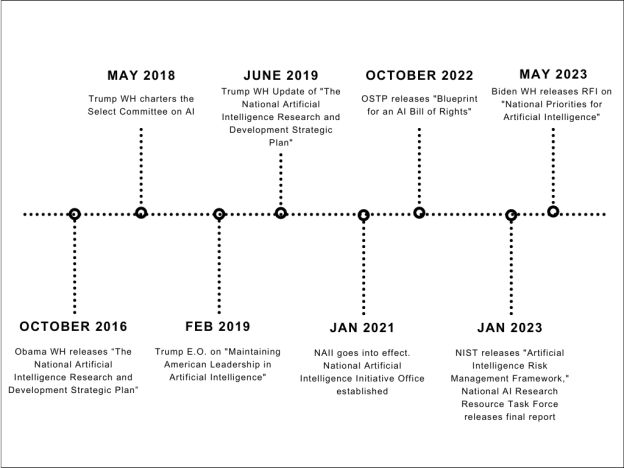Welcome to the initial issue of AI: The Washington Report, a joint undertaking of Mintz and its government affairs affiliate, ML Strategies (MLS). The accelerating advances in artificial intelligence ("AI") and the practical, legal, and policy issues AI creates understandably have also exponentially increased the federal government's interest in AI and its implications. In our weekly reports, we hope to keep our clients and friends apeast of developments in that Washington-focused set of potential legislative, executive, and regulatory activities. Other Mintz and ML Strategies subject matter experts will continue to discuss and analyze other aspects of what could be characterized as the "AI Revolution."
Our initial report focuses upon the White House and its recent issuance of a series of questions to the public at large, directed to ultimately creating "National Priorities for Artificial Intelligence." As you will see, the Biden administration is building upon initiatives that began in the Obama administration and continued during the Trump administration. Our key takeaways are:
- Each administration, since 2016, has committed itself to developing a national AI strategy. In spite of ideological differences, there has been remarkable bipartisan continuity between administrations on this issue.
- The National Artificial Intelligence Initiative Office ("NAIIO"), housed within the White House Office of Science and Technology Policy ("OSTP"), is the body most likely to implement a unified federal framework on AI, if it receives the funding and expertise needed to do so. Stakeholders should closely monitor the upcoming appropriations process following the enactment of the debt limit increase.
- Key reports and frameworks (such as "Automation and the U.S. Workforce") that will inform federal strategy on AI are expected to be released sometime this year. We will discuss the Biden Administration's recently released update to the "The National Artificial Intelligence Research and Development Strategic Plan" in a subsequent newsletter.
The focus of this report is the White House's efforts to develop a policy approach surrounding AI. This effort started in the Obama administration. Most recently, on May 23, 2023, the OSTP released a request for information ("RFI") on "National Priorities for Artificial Intelligence."1 This memorandum details the RFI and provides background on key executive-level actions regarding artificial intelligence taken by the Obama, Trump, and Biden administrations from 2016 to 2023.
Summary: The "National Priorities for Artificial Intelligence" RFI
The RFI adopts a cautious stance on the potential of AI, reasoning that while the technology may "improve the lives of the American people and solve some of the toughest global challenges," AI also poses "serious risks to democracy, the economy, national security, civil rights, and society at large."2 In order to put the federal government on a footing in which agencies can best exploit the advantages and avoid the risks of AI, the OSTP intends to leverage the RFI to formulate a "National Artificial Intelligence (AI) Strategy." The RFI asks 29 questions divided into five main categories. To help inform the national AI strategy, respondents are also invited to submit comments that do not relate to the topic areas detailed below.
- Protecting rights, safety, and national security: What regulatory and technological frameworks should be put in place to protect civil rights and national security from AI?
- Advancing equity and strengthening civil rights: What are ways in which AI systems can enhance equity and promote democratic values in the United States and around the world?
- Bolstering democracy and civil participation: How can AI be used to strengthen civic engagement, and how can AI's threats to democracy be mitigated?
- Promoting economic growth and good jobs: How can AI be harnessed to stimulate economic growth and productivity? How can we prepare for AI-induced workforce instability in the United States and around the world?
- Innovating in public services: How can AI be integrated into public services in a manner that increases efficiency while safeguarding rights and safety?
Combining comments received in this and previous RFIs, OSTP aims to formulate a "whole-of-society approach" to AI that encompasses government, industry, and researchers, both inside and outside of the United States.3 Comments on the RFI are due by 5:00 pm ET on July 7, 2023.4 Commentary provided to five previous RFIs are being considered in the development of the national AI strategy.5 Comments submitted to these prior RFIs need not be resubmitted in order to be considered in the development of the national AI strategy.
To understand the origins of this effort, along with the governmental bodies currently in place that may be charged to execute any initiative adopted, it is useful to review the course of executive-level AI initiatives from late in the Obama administration to the present.
The Obama White House: Building the Strategic Plan
In the waning months of the Obama administration, the White House released two reports on AI. The first, released in October 2016 and entitled "Preparing for the Future of Artificial Intelligence," presented a poad survey of the state of the technology at that time.6 Predicting "rapid progress in the field of specialized artificial intelligence," the report called on the federal government to increase AI research and development ("R&D") funding, encourage AI education through the dissemination of open training datasets and data standards, and consider how AI can be beneficially integrated into the functioning of key federal agencies.7
While this first report confined itself to abstract principles and recommendations, the subsequent report concerned the implementation of these goals. "The National Artificial Intelligence Research and Development Strategic Plan" ("Strategic Plan") sought to provide a "high-level framework that can be used to identify scientific and technological needs in AI, and to track the progress and maximize the impact of R&D investments to fill those needs."8 Recognizing that there exist vital areas in AI research "that industry is unlikely to address and thus areas that are most likely to benefit from Federal investment," the report recommends that the federal government:
- Make long-term investments in AI research
- Develop effective methods for human-AI collaboration
- Understand and address the ethical, legal, and societal implications of AI
- Ensure the safety and security of AI systems
- Develop shared public datasets and environments for AI training and testing
- Measure and evaluate AI technologies through standards and benchmarks
- Better understand the national AI R&D workforce needs
These seven principles have guided the AI strategies of the Trump and Biden administrations.
The Trump White House: From Planning to Institutionalization
The Trump White House adopted as its own the principles set forth in the Obama administration's Strategic Plan. In May 2018, the White House chartered a "Select Committee on AI" ("Select Committee"). Consisting of senior R&D officials from across the federal government, the Select Committee facilitates the "planning, coordination, and communication of AI R&D, demonstration, and education and workforce training activities among Federal departments and agencies."9
In Fepuary 2019, Trump promulgated an executive order ("E.O.") entitled "Maintaining American Leadership in Artificial Intelligence."10 This E.O. tasked the Select Committee with formulating a "coordinated Federal Government strategy" called the "American AI Initiative." The purpose of the American AI Initiative would be to "enhance the scientific, technological, and economic leadership position of the United States in AI R&D." In service of this aim, the American AI Initiative would "drive technological peakthroughs," facilitate the development of technical standards, prepare the American workforce for the AI revolution, ensure AI's development does not harm civil liberties, and help create a global AI ecosystem favorable to the United States and its allies.11
To further develop these principles, the Select Committee revisited the 2016 Strategic Plan, releasing an updated version in July 2019.12 This document detailed the major developments in AI technology that occurred over the preceding three years, updating the commentary accompanying the original seven principles accordingly. The 2019 update also added an eighth principle, "Expand Public-Private Partnerships to Accelerate Advances in AI," calling for the establishment of a "more robust national Government-University-Industry research partnership."13
Calls for a singular coordinator of federal AI strategy found their fulfillment in the National Artificial Intelligence Initiative Act of 2020 ("NAII").14 This law established the "National Artificial Intelligence Initiative Office" ("NAIIO"), a body located within the OSTP with a mandate similar to that of the American AI Initiative proposed in Trump's 2019 executive order. NAII chartered the NAIIO to "serve as the point of contact on Federal artificial intelligence activities for Federal departments and agencies, industry, academia, nonprofit organizations, professional societies, State governments" and other relevant bodies.15 In essence, the NAIIO serves as the coordinating arm of the federal government's AI activities.
On January 1, 2021, the NAIIO came into being. Just weeks later, Biden assumed the presidency, ushering in further development of the federal AI strategy.
The Biden White House: Towards a National AI Strategy
Along with establishing the NAIIO, the NAII commissioned three major reports intended to guide the development of a coherent federal AI strategy. The first, a National Academies impact study regarding AI and the American workforce entitled "Automation and the U.S. Workforce," has yet to be completed at the time of writing.16
The NAII also commissioned the National Institute of Standards and Technology ("NIST") to release and periodically update "a voluntary risk management framework for trustworthy artificial intelligence systems."17 Released in January 2023, the "Artificial Intelligence Risk Management Framework" seeks to provide designers of AI systems "with approaches that increase the trustworthiness of AI systems...to help foster the responsible design, development, deployment, and use of AI systems over time."18 By providing developers of autonomous systems with clear and voluntary guidelines, the risk framework hopes to foster awareness of AI risks "so society can benefit from AI while also being protected from its potential harms."19
Finally, NAII directed NIST and the OSTP to establish a "National Artificial Intelligence Research Resource Task Force" ("Task Force"). NAII chartered the Task Force to create the framework for a "National Artificial Intelligence Research Resource" ("NAIIR"), a "system that provides researchers and students... [with access to] artificial intelligence–ready government and non-government datasets."20 In January 2023, the Task Force released its final report, detailing its proposal for the NAIRR, a resource that would provide datasets, computational infrastructure, and educational materials to researchers, students, and AI professionals.21 The NAIRR would cost $2.6 billion over six years.

Figure 1: Timeline of Executive-Level AI Strategic Planning (2016-2023)
While the NAII envisioned an expansive coordinating role for the NAIIO, it is unclear whether the office yet has the funding and organizational capacity to execute this mandate. The May 2023 inaugural report of the National Artificial Intelligence Advisory Committee ("NAIAC"), an advisory body to the president and the NAIIO chartered by the NAII, calls for additional funding for the NAIIO, the filling of key vacancies (including that of director) at the NAIIO, and the appointment of a chief AI officer in the NAIIO who would coordinate the implementation of AI frameworks with relevant federal agencies.22
In addition to overseeing the studies commissioned by the NAII, the Biden administration commissioned the OSTP to publish an RFI on an "AI Bill of Rights."23 After a year of consultation, the OSTP released the "Blueprint for an AI Bill of Rights" in October 2022, a document containing five principles that "should guide the design, use, and deployment of automated systems to protect the American public in the age of artificial intelligence."24 These principles are:
- Safe and Effective Systems: AI systems should be designed with appropriate diligence, consultation with relevant stakeholders, safety measures in place, and without "an intent or reasonably foreseeable possibility" of endangering individuals' safety.25
- Algorithmic Discrimination Protections: Designers of algorithmic systems should implement "proactive and continuous measures" to ensure that their products are neither directly nor indirectly discriminating against certain populations.26
- Data Privacy: "Designers, developers, and deployers of automated systems should seek your permission and respect your decisions regarding collection, use, access, transfer, and deletion of your data in appropriate ways and to the greatest extent possible..."27
- Notice and Explanation: Individuals impacted by the use of AI systems, "should know that an automated system is being used and understand how and why it contributes to outcomes" that concern them.28
- Human Alternatives, Consideration, and Fallback: Individuals subject to AI systems should be able to, "opt out from automated systems in favor of a human alternative, where appropriate."29
Conclusion: The "National Priorities" RFI in Context
Despite rapid technological changes and stark ideological differences between administrations, there is remarkable continuity between the Strategic Plan released by the Obama administration, the various institutions put in place by the Trump administration, and the initiatives launched by the Biden administration. For each of the eight R&D strategies laid out in the Obama and Trump Strategic Plans, there exists a corresponding institution or framework put in place during the Trump or Biden administration.
|
AI & R&D Strategy |
Implementation |
|
1. Make long-term investments in AI research |
NAIRR |
|
2. Develop effective methods for human-AI collaboration |
NAIIO |
|
3. Understand and address the ethical, legal, and societal implications of AI |
AI Bill of Rights |
|
4. Ensure the safety and security of AI systems |
AI Risk Management Framework |
|
5. Develop shared public datasets and environments for AI training and testing |
NAIRR |
|
6. Measure and evaluate AI technologies through standards and benchmarks |
Select Committee on AI |
|
7. Better understand the national AI R&D workforce needs |
Automation and the U.S. Workforce |
|
8. Expand public-private partnerships to accelerate advances in AI |
Select Committee on AI |
Figure 2: Institutions and Frameworks Responding to Obama
and Trump AI R&D Strategies
In its proper context, then, the May 2023 RFI on "National Priorities for Artificial Intelligence" is better understood as an executive step rather than a starting point for the federal government's strategic response to AI. If such a strategy is eventually formulated, the body likely in charge of coordinating its implementation, the NAIIO, will have had years of experience behind it.
Footnotes
1. Office of Science and Technology Policy, Request for Information: National Priorities for Artificial Intelligence, May 23, 2023.
2. Request for Information: National Priorities for Artificial Intelligence, 2.
3. Request for Information: National Priorities for Artificial Intelligence, 2.
4. Office of Science and Technology Policy, Request for Information: National Priorities for Artificial Intelligence. Comments can be submitted through the public comment portal here: https://www.regulations.gov/document/OSTP-TECH-2023-0007-0001.
5. These RFIs are as follows: OSTP's RFI to the Update of the National Artificial Intelligence Research and Development Strategic Plan, the National Telecommunication and Information Administration's RFI on AI Accountability Policy, the OSTP's RFI on Implementing Initial Findings and Recommendations of the National Artificial Intelligence Research Resource Task Force, OSTP's RFI on Automated Worker Surveillance and Management, and OSTP's RFI on Public and Private Sector Uses of Biometric Technologies.
6. The White House, Preparing for the Future of Artificial Intelligence, Executive Office of the President, National Science and Technology Council Committee on Technology, October 2016.
7. Preparing for the Future of Artificial Intelligence, Forward.
8. The White House, The National Artificial Intelligence Research and Development Strategic Plan, National Science and Technology Council, Networking and Information Technology Research and Development Subcommittee, October 2016.
9. The White House, Charter of the Select Committee on Artificial Intelligence, January 5, 2021.
10. Executive Order 13859, Maintaining American Leadership in Artificial Intelligence, February 11, 2019.
11. Executive Order 13859 of February 11, 2019, 3967.
12. The White House, The National Artificial Intelligence Research and Development Strategic Plan: 2019 Update, A Report by the Select Committee on Artifical Intelligence of the National Sciences & Technology Council, June 2019.
13. Strategic Plan (2019 Update), 40.
14. National Artificial Intelligence Initiative Act of 2020, Pub. L. 116-283.
15. National Artificial Intelligence Initiative Act of 2020, 5.
16. The National Academies of Sciences, Engineering, and Medicine, Automation and the U.S. Workforce: An Update, pending study.
17. National Artificial Intelligence Initiative Act of 2020, 14.
18. National Institute of Standards and Technology, Artificial Intelligence Risk Management Framework (AI RMF 1.0), January 2023.
19. Artificial Intelligence Risk Management Framework (AI RMF 1.0), 2.
20. National Artificial Intelligence Initiative Act of 2020, 11.
21. National Artificial Intelligence Research Resource Task Force, Strengthening and Democratizing the U.S. Artificial Intelligence Innovation Ecosystem: An Implementation Plan for a National Artificial Intelligence Research Resource, January 2023.
22. National Artificial Intelligence Advisory Committee (NAIAC) Year 1 report, May 2023.
23. Request for Information: National Priorities for Artificial Intelligence.
24. The White House, Blueprint for an AI Bill of Rights Making Automated Systems Work for the American People, October 2022.
25. Blueprint for an AI Bill of Rights, 15.
26. Ibid, 5.
27. Ibid, 6.
28. Ibid, 6.
29. Ibid, 7.
The content of this article is intended to provide a general guide to the subject matter. Specialist advice should be sought about your specific circumstances.




